
A television flickers in the night, broadcasting a static signal that breaks with an episode of Night Springs. The Twilight Zone parody uses Rod Serling styled narration to set the stage about a champion of light pursuing his evil double, Mr. Scratch, in one of several episodes written by Alan Wake before his career as a novelist took shape.
Remedy uses the show to frame a standalone entry point for gamers not familiar with the original 2010 release, but this play of events might also serve as a conduit for Alan from his prison within the Dark Place. While radio broadcasts within the game give glimpses into a world that has continued without Alan, conversations and manuscript pages suggest that the writer may be using the television show in his quest to return to his wife and former life.
Remedy continues to revel in the possibilities their horror series stirs, giving fans plenty to chew on regarding the writer’s fate. The only certainty is that players must find a way to stop Mr. Scratch from trapping them in a campy horror narrative, and that Alan’s journey through the night continues within this American Nightmare.
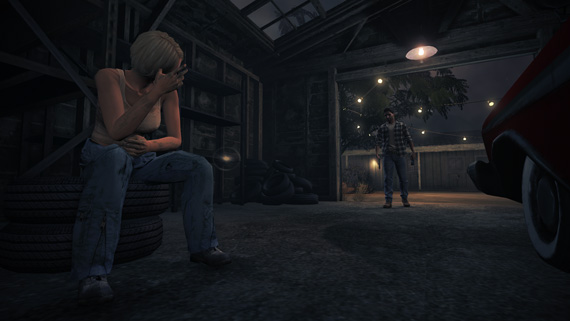
The story mode of American Nightmare unfolds across three key set-pieces – a rustic motel and diner by an oil derrick, an observatory, and a drive-in theatre. Aside from the shift toward a pulp horror aesthetic, the most significant deviation from the original game is space, with these areas offering more compact environments.
Players won’t need to run through seemingly endless forests to reach locations, finding themselves instead delivered to areas where a series of nearby objectives await them. This move doesn’t sacrifice a sense of isolation so much as tighten the pacing, with players never long for discovering events that move the story forward, along with recurring bouts of action against Mr. Scratch’s dark minions. There are still reasons to wander slightly off course however, and standing in these desert locations whilst staring off into the distance convinces an incredible sense of space beyond the player’s reach.
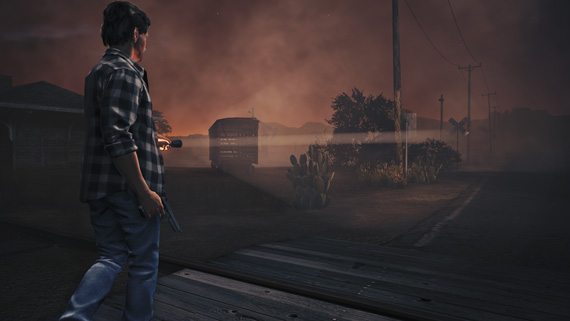
The tightened focus makes American Nightmare feel much more objective based than the 2010 release, with Alan fetching items or activating valves and switches, each of these goals waiting to unleash a wave of opposition with the Taken returning to cut Alan down. Alan still fights these creatures by using his flashlight to break the darkness protecting them and then proceeding to fill them with bullets until they explode. Aiding a quicker pace of action, the flashlight recharges much more quickly, almost making batteries unnecessary, and Alan also sports a three bar health meter that is again regenerated whenever he steps into protective light – if players only lose part of a bar, it will regenerate without light.
Areas offer a great deal of ammunition, including supply boxes that will restock any weapons currently being carried. Where the original game focused on supplying key weapons at certain times, American Nightmare encourages players to find their favorites and stick with them – including the satisfying ‘thunk’ sound made by the new nail gun.
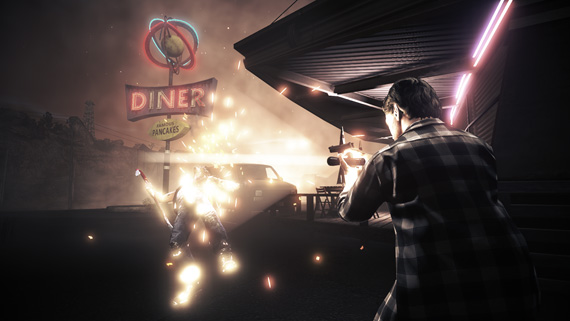
While there are no coffee thermos’ to discover, players will still find manuscript pages in each of the areas, offering insight into characters as well as questions surrounding Alan’s attempt to escape the Dark Place. The looping nature of the story makes finding pages trickier, but the radar will offer some assistance in the search. Finding these pages is essential for unlocking a series of weapon crates placed throughout the game. These crates require a certain amount of pages to be opened, and offer heavier weapons such as the combat shotgun, assault rifle, sub-machine gun, and magnum.
The Taken have also evolved, with familiar grunts joined by the splitter, who will multiply in two if hit by focused light, a giant that takes several more shots to down and casts a very intimidating shadow, and an enemy that is formed by swarms of birds and is able to jump back into the air to gain the upper hand. If this is leading you to conclude that action is a more consistent occurrence in American Nightmare, you are correct. Fighting the Taken is also a more streamlined experience that allows for an easier flow of combat – Alan even turns his head to warn you of incoming threats. But fans should recognize familiar elements and habits, and not be concerned that Alan is simply machine-gunning his way through an empty set of stages.
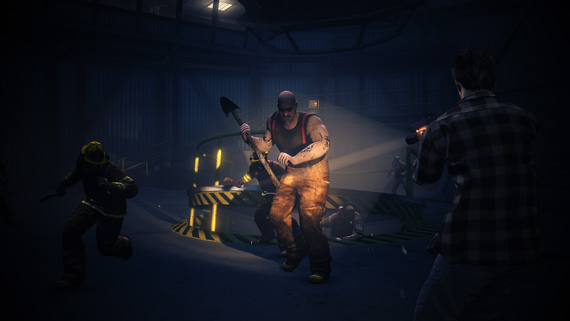
Players won’t be using light to bring words into physical existence this time around. Instead, Alan has written paragraphs that offer him a chance to change reality, assuming he can make the events that are written happen. This task is accomplished by lightly interacting with the environment, placing or changing objects to match the words on a page. It’s an adequate means of allowing players to feel as if they have a hand in creating a new reality, but still consists of pressing ‘X’ to accomplish ‘Y’ – and there’s every reason to want for a better solution.
Keep in mind that most other games would escape such light criticism, and blame Remedy for convincing me that they are often skating around the discovery of truly brilliant new ideas about interaction and the relationship between words and reality.
This new word game ultimately leads to Alan trying to recover a signal that will arm him with the means to change the ending of the entire story, starting the looping narrative that sees him revisiting areas three times. The idea of revisiting set-pieces might sound horrible, and there were brief moments where I expected it to be, but Remedy’s script creates changes with each revisit that staves of cursing the repetition.
There’s a measured paced to difficulty, which slowly rises until you reach the final stages and Remedy uses music and hordes to capture that same sense of glory from the rock stage of the original game. Chewing through the story mode should keep you entertained for five hours depending on how long you linger, and there’s certainly reason to, with tormenting television signals from Mr. Scratch and radio broadcasts featuring old friends that offer insight into what may be going on while Alan has been missing.
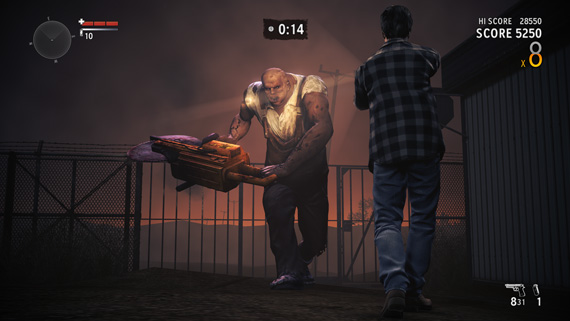
American Nightmare also features an arcade mode, which Remedy has setup as the emphasis even though fans will immediately be pulled toward the story first and foremost – plus you’ll really want those manuscript pages. The premise of survival mode should be familiar to FPS-minded gamers, with Alan using evasion and weapons to survive until the sun rises – 10 minute bouts against increasing waves of the Taken. At the start of each stage, the emphasis is on gathering weapons and flares, particularly in finding the weapon crates from the story mode to gain a quicker means of dispatching enemies.
There are five primary sets, the cemetery, ghost town, oil field, caves, and trailer park. Earning stars with high scores will unlock each, including a second variant of these stages that gives new meaning to the word ‘nightmare’ as the Taken overrun Alan. Despite the familiarity of the concept, the arcade mode does strike some fresh ground.
Maintaining kill streaks while keeping supplied on health and ammo within the ten minute timeframe is incredibly challenging. You can bend the rules a little, say by leaving a single grenadier enemy alive, who will toss easily avoided grenades while you scurry around and resupply. But this takes away from your time, and grabbing a score worth bragging about doesn’t allow for poor time management. Players are also going to have to work hard to earn enough stars to feed the demands for unlocking additional stages.
The pull of arcade mode is the way the Taken aren’t soldiers firing bullets and forcing you to take cover to find a moment of peace. Much like a zombie horde, there’s no relief to be had during these bouts, save for the temporary aid of light to heal wounds. Several sessions have found me sure of my supplies only to be engulfed by enemies attacking from every direction and quickly depleting a full stock of ammo, offering some sincere stress that makes the dawn a welcomed sight.
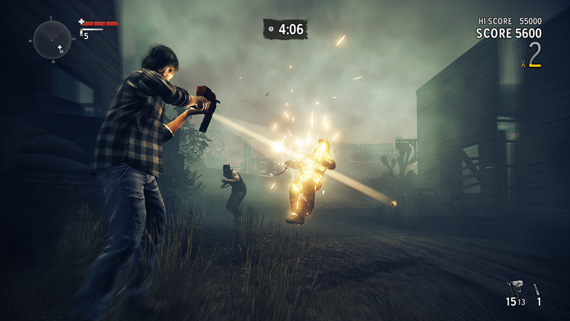
American Nightmare’s arcade mode offers an easy means of revisiting a key element of Alan Wake, which certainly isn’t an easy game to jump into for short bouts of play. Those arcade stages create a space that is easy to revisit, but may be a harder sell for those that saw combat more as a necessary distraction to the narrative. But the combat is fluid and dramatic, with a theatrical edge to the evasive slowdown and bursts of light that drives back enemies, creating a survival challenge not easily comparable to others.
If action doesn’t interest you, this release might feel a bit light. While story mode is an easy justification for the visit, the arcade mode is the larger reason for investment and revisits, so if you aren’t keen on playing simply with the battle mechanics this may become a difficult purchasing decision.
Keeping in mind that I’m a card carrying fan of Alan Wake, I’ll suggest that the level of presentation in a story mode that is half the length of many modern retail releases, along with an arcade mode that gives fresh replay opportunities, shouldn’t leave fans of the series feeling any buyer’s remorse – this level of quality is sadly rare on Xbox LIVE Arcade. Whether or not American Nightmare can serve as a standalone gateway drug to newcomers is a question I don’t feel qualified to answer – all the more reason for even more of you to play the original game.
American Nightmare provides a more focused product that the DLC that followed Alan Wake’s original release, offering a story that is more structured, but still allows fans to pick for tidbits to their heart’s content. The supporting characters aren’t as endearing, acting more as immediate conduits of help or information for Alan, colored by the pulp horror style Remedy has said to be aiming for here, which mostly seems to show in the new enemy designs more than anything else. But from the moment the game begins, American Nightmare stirs memories of the original Alan Wake and captures many of the elements that have kept me waiting to find out how Alan’s journey through the night would continue. If you’ve been in the same boat, then you really don’t need my help making a decision here.
Remedy
Publisher
Microsoft Studios
System
Xbox 360 (Xbox LIVE Arcade)
Modes
Singleplayer
Release Date
February 22, 2012
Price
1200 Microsoft Points
*A copy of this title was provided by the publisher for review
